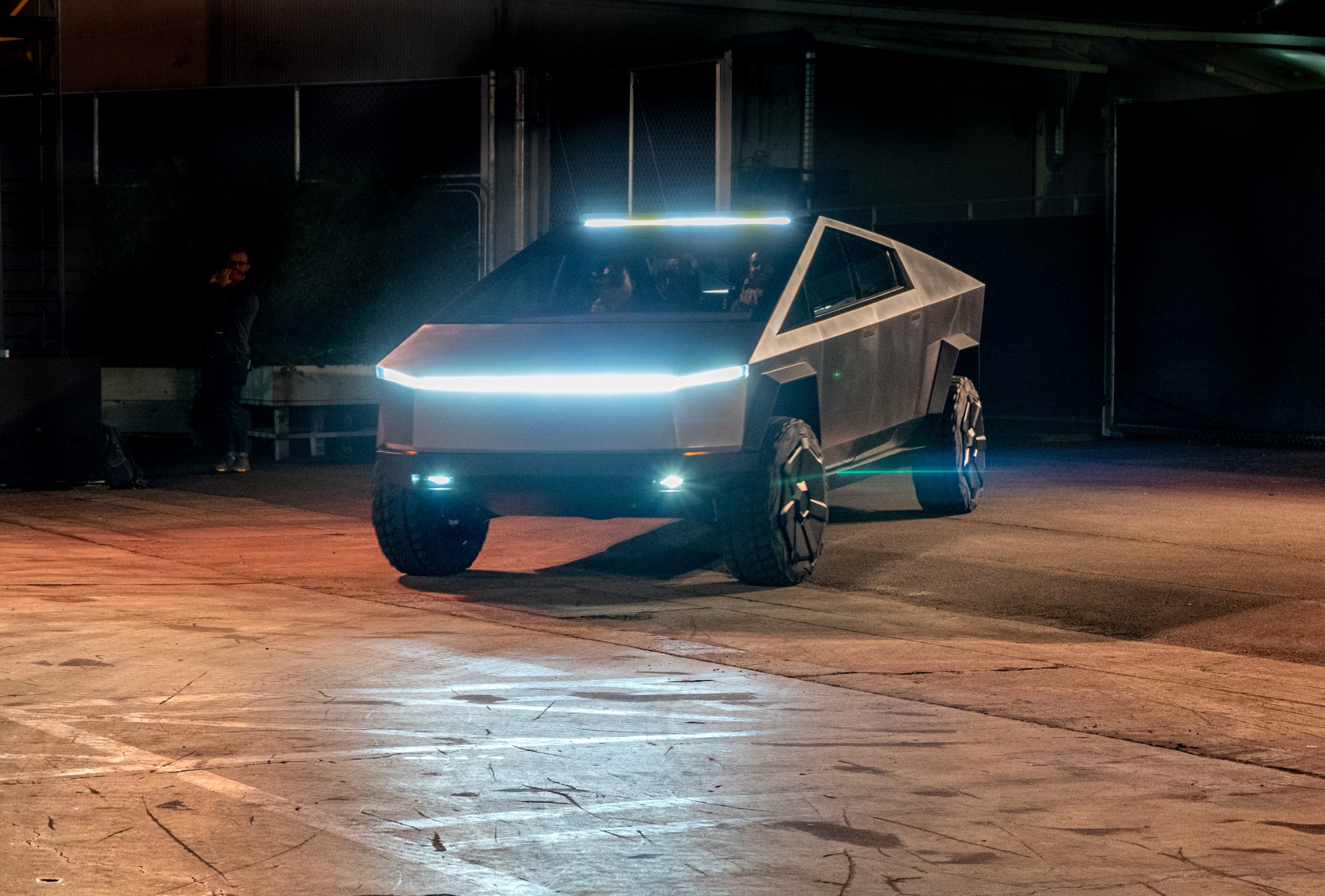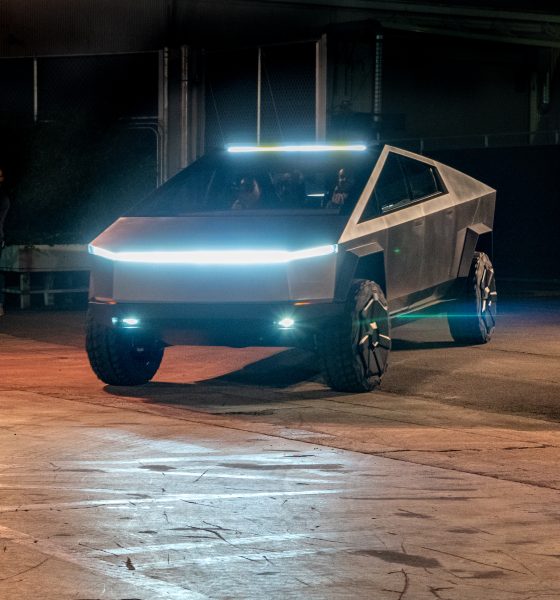

News
Tesla Cybertruck’s ‘simple’ design goes way deeper than you think
Elon Musk’s Cybertruck is Tesla’s boldest vehicle yet. With its sharp edges and its unapologetically futuristic look, the Cybertruck appears to be a vehicle that is designed to shock and polarize. Yet, behind its almost brutalist exterior lies a clever theme that gives the Cybertruck the potential to be Tesla’s most disruptive vehicle to date, mainly due to its production efficiencies that are tied to its very exoskeleton.
When Tesla unveiled the Cybertruck on Thursday night, a good number of netizens and those who were in attendance at the event were shocked. The massive vehicle was clad in cold, hard, unpainted stainless steel, and its sharp triangular design makes it look extremely different from every other pickup truck on the market. Elon Musk has been saying that the Cybertruck will be polarizing, and it definitely was.
Unlike Tesla’s other vehicles like the Model S, X, and Model 3, the Cybertruck uses an exoskeleton that is made from a new variant of 3000 series stainless steel that’s cold-worked several times. The material is tough and is not unlike the steel used in SpaceX’s gigantic Starship. With this system in place, Tesla is able to skip the traditional stamping process for the vehicle’s body panels. Instead, the Cybertruck’s frame will be laser cut and folded, much like an origami that’s made of steel.
And just like actual Japanese origami, the Cybertruck’s stainless steel body is actually folded into shape instead of being cut up into several pieces and stamped multiple times by massive machines, according to an exclusive look into the vehicle by MotorTrend. Considering that the stamping process is very capital intensive (stamping machines are among the largest and most expensive components of a car factory), Tesla’s origami-style design for the Cybertruck becomes a very cost-effective way to produce a massive, durable, futuristic vehicle at relatively low cost.
Elon Musk recently elaborated on this in a recent tweet, stating that the Cybertruck’s 3mm-thick stainless steel exoskeleton is not very friendly to stamping machines. “Reason Cybertruck is so planar is that you can’t stamp ultra-hard 30X steel, because it breaks the stamping press,” Musk wrote.
Using stainless steel also allows Tesla to skip out on the painting of the vehicle, allowing the company to not use a paint shop in the vehicle’s production process. This results in further savings, while also avoiding the paint headaches that Tesla had to deal with when it ramped its previous vehicles, particularly the Model 3.
The absence of the stamping press and the paint shop in the Cybertruck’s production has another advantage, in the way that the vehicle’s production line could probably be done in a relatively small area. Without giant stamping presses and an expansive paint shop, after all, Tesla could produce the Cybertruck in an assembly line that is designed for speed.
The EV community was shocked by the starting price of the Cybertruck just as much as it was shocked by the vehicle’s design. Starting at $39,990, the base Cybertruck is very competitively priced and is chock full of tech that its competitors simply cannot hold a candle to. Couple this with a design that is optimized for efficiency, and the vehicle could very well be a disruptor on its own right in the highly-competitive pickup truck segment.

News
Tesla FSD fleet is nearing 7 billion total miles, including 2.5 billion city miles
As can be seen on Tesla’s official FSD webpage, vehicles equipped with the system have now navigated over 6.99 billion miles.

Tesla’s Full Self-Driving (Supervised) fleet is closing in on almost 7 billion total miles driven, as per data posted by the company on its official FSD webpage.
These figures hint at the massive scale of data fueling Tesla’s rapid FSD improvements, which have been quite notable as of late.
FSD mileage milestones
As can be seen on Tesla’s official FSD webpage, vehicles equipped with the system have now navigated over 6.99 billion miles. Tesla owner and avid FSD tester Whole Mars Catalog also shared a screenshot indicating that from the nearly 7 billion miles traveled by the FSD fleet, more than 2.5 billion miles were driven inside cities.
City miles are particularly valuable for complex urban scenarios like unprotected turns, pedestrian interactions, and traffic lights. This is also the difference-maker for FSD, as only complex solutions, such as Waymo’s self-driving taxis, operate similarly on inner-city streets. And even then, incidents such as the San Francisco blackouts have proven challenging for sensor-rich vehicles like Waymos.
Tesla’s data edge
Tesla has a number of advantages in the autonomous vehicle sector, one of which is the size of its fleet and the number of vehicles training FSD on real-world roads. Tesla’s nearly 7 billion FSD miles then allow the company to roll out updates that make its vehicles behave like they are being driven by experienced drivers, even if they are operating on their own.
So notable are Tesla’s improvements to FSD that NVIDIA Director of Robotics Jim Fan, after experiencing FSD v14, noted that the system is the first AI that passes what he described as a “Physical Turing Test.”
“Despite knowing exactly how robot learning works, I still find it magical watching the steering wheel turn by itself. First it feels surreal, next it becomes routine. Then, like the smartphone, taking it away actively hurts. This is how humanity gets rewired and glued to god-like technologies,” Fan wrote in a post on X.
News
Tesla starts showing how FSD will change lives in Europe
Local officials tested the system on narrow country roads and were impressed by FSD’s smooth, human-like driving, with some calling the service a game-changer for everyday life in areas that are far from urban centers.

Tesla has launched Europe’s first public shuttle service using Full Self-Driving (Supervised) in the rural Eifelkreis Bitburg-Prüm region of Germany, demonstrating how the technology can restore independence and mobility for people who struggle with limited transport options.
Local officials tested the system on narrow country roads and were impressed by FSD’s smooth, human-like driving, with some calling the service a game-changer for everyday life in areas that are far from urban centers.
Officials see real impact on rural residents
Arzfeld Mayor Johannes Kuhl and District Administrator Andreas Kruppert personally tested the Tesla shuttle service. This allowed them to see just how well FSD navigated winding lanes and rural roads confidently. Kruppert said, “Autonomous driving sounds like science fiction to many, but we simply see here that it works totally well in rural regions too.” Kuhl, for his part, also noted that FSD “feels like a very experienced driver.”
The pilot complements the area’s “Citizen Bus” program, which provides on-demand rides for elderly residents who can no longer drive themselves. Tesla Europe shared a video of a demonstration of the service, highlighting how FSD gives people their freedom back, even in places where public transport is not as prevalent.
What the Ministry for Economic Affairs and Transport says
Rhineland-Palatinate’s Minister Daniela Schmitt supported the project, praising the collaboration that made this “first of its kind in Europe” possible. As per the ministry, the rural rollout for the service shows FSD’s potential beyond major cities, and it delivers tangible benefits like grocery runs, doctor visits, and social connections for isolated residents.
“Reliable and flexible mobility is especially vital in rural areas. With the launch of a shuttle service using self-driving vehicles (FSD supervised) by Tesla in the Eifelkreis Bitburg-Prüm, an innovative pilot project is now getting underway that complements local community bus services. It is the first project of its kind in Europe.
“The result is a real gain for rural mobility: greater accessibility, more flexibility and tangible benefits for everyday life. A strong signal for innovation, cooperation and future-oriented mobility beyond urban centers,” the ministry wrote in a LinkedIn post.
News
Tesla China quietly posts Robotaxi-related job listing
Tesla China is currently seeking a Low Voltage Electrical Engineer to work on circuit board design for the company’s autonomous vehicles.

Tesla has posted a new job listing in Shanghai explicitly tied to its Robotaxi program, fueling speculation that the company is preparing to launch its dedicated autonomous ride-hailing service in China.
As noted in the listing, Tesla China is currently seeking a Low Voltage Electrical Engineer to work on circuit board design for the company’s autonomous vehicles.
Robotaxi-specific role
The listing, which was shared on social media platform X by industry watcher @tslaming, suggested that Tesla China is looking to fill the role urgently. The job listing itself specifically mentions that the person hired for the role will be working on the Low Voltage Hardware team, which would design the circuit boards that would serve as the nervous system of the Robotaxi.
Key tasks for the role, as indicated in the job listing, include collaboration with PCB layout, firmware, mechanical, program management, and validation teams, among other responsibilities. The role is based in Shanghai.
China Robotaxi launch
China represents a massive potential market for robotaxis, with its dense urban centers and supportive policies in select cities. Tesla has limited permission to roll out FSD in the country, though despite this, its vehicles have been hailed as among the best in the market when it comes to autonomous features. So far, at least, it appears that China supports Tesla’s FSD and Robotaxi rollout.
This was hinted at in November, when Tesla brought the Cybercab to the 8th China International Import Expo (CIIE) in Shanghai, marking the first time that the autonomous two-seater was brought to the Asia-Pacific region. The vehicle, despite not having a release date in China, received a significant amount of interest among the event’s attendees.








